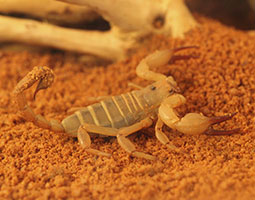Urodacus yaschenkoi
Description

Desert scorpions are found in a variety of locations in central Australia. They are one of the largest scorpions in Australia with males growing in excess of 100mm from mouth to tip of sting. The females are generally a bit shorter in length, although more robust in the body.
Desert scorpions have prominent pedipalps (pincers) which they use to secure food. Their long tail culminates in a stinger (telson) that contains a venom gland that the scorpion uses to inject into their prey.
Mating and molting occurs in the warmer months. Females give birth to live young, which she carries on her back for the first few days until they are strong enough to become independent.
Scorpions can live up to 25 years.
Adaptations
- Possess a stinging tail that they use to subdue large prey or defend themselves against predators
- Construct burrows which they use to ambush prey and hide from predators
Feeding relationships
- What I eat: insects, spiders, centipedes, other scorpions
- What eats me: large centipedes, tarantulas, birds (especially owls), mammals (e.g. bats, shrews, mice)
Interesting facts
Scorpions fluoresce (glow) under ultraviolet light. Scientists use this characteristic to help them find them in the field. No species of Australian scorpions are able to deliver a sting capable of causing death in humans.